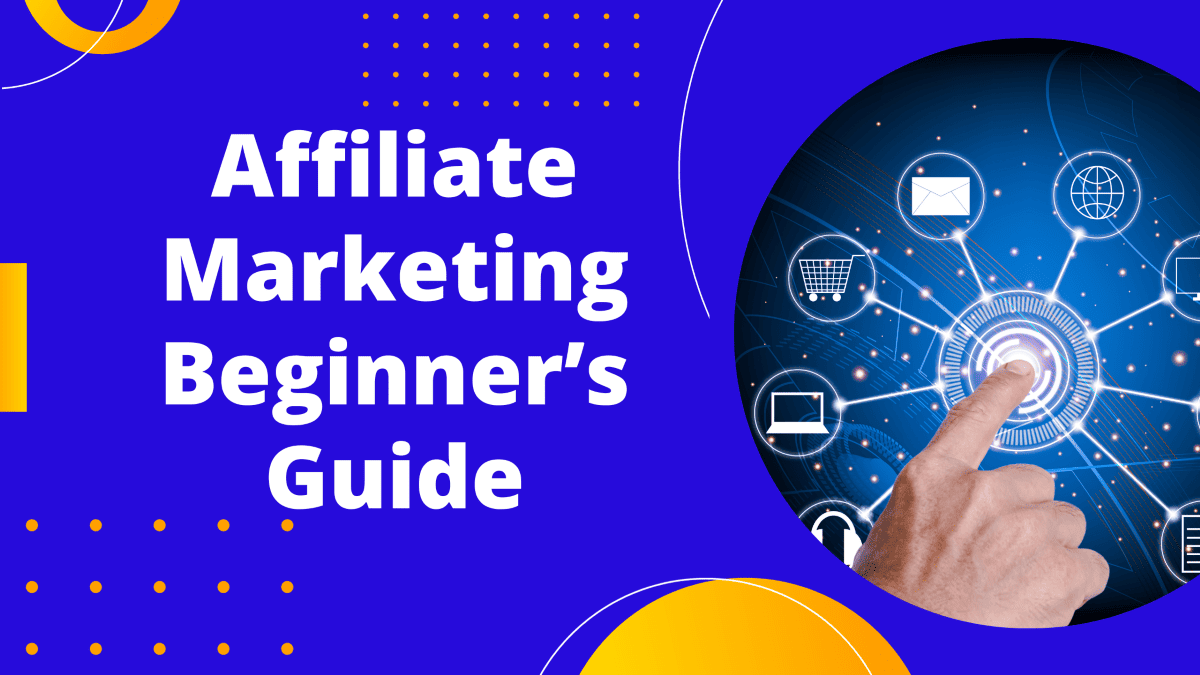
Welcome to the world of affiliate marketing!
If you’re new to the idea of making money online by promoting products and earning commissions, you’ve come to the right place.
In this affiliate marketing for beginners guide, we’ll walk you through every step of how to become an affiliate marketer, share marketing tips and explain all the strategies that affiliate marketers use to earn revenue.
By the end of this journey, you’ll have a solid foundation to start your own affiliate marketing venture and potentially turn it into a source of passive income.
Purpose of this Guide
You might wonder, is this guide right for me? Absolutely! Whether you’re a beginner looking to get started in the affiliate marketing world, or someone with a bit of experience wanting to up your game, this guide is crafted for you.
We’ll cover the basics, explore different strategies, delve into some tech-savvy tools, and even debunk common myths surrounding affiliate marketing.
By the end of this guide, you’ll have a solid understanding of how affiliate marketing works, and how to kickstart your affiliate marketing journey. Ready to explore the fascinating world of affiliate marketing? Let’s dive in!
What is Affiliate Marketing?
Simply put, affiliate marketing is a performance-based marketing model.
Here individual or the affiliate earns a commission by promoting products or services of companies or merchants. When someone makes a purchase through your unique affiliate link, you get paid.
It’s a win-win! The merchant gets more sales, and you earn affiliate income. Affiliate marketing is a fantastic method to earn passive income while staying at home.
Understanding Affiliate Marketing: Merchants, Affiliate Marketer, and Consumers
In the world of affiliate marketing, three main players make things happen. Let’s get to know them: the Merchants, the Affiliates, and the Consumers.
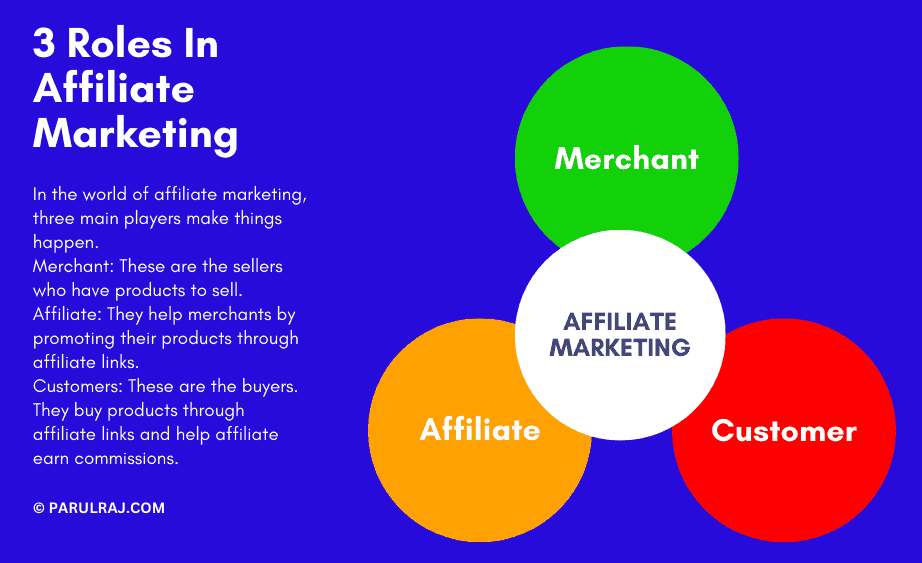
Merchants
Merchants are the sellers.
They have products or services they want to sell. Anyone with something to sell can be a merchant, big companies or small local shops.
They start the affiliate marketing program and offer affiliate commission for promoting their products.
Affiliates Or Affiliate Marketer
Next up, the Affiliates. They help sell the merchant’s stuff.
They tell people about the products or services using their own websites or social media.
When people buy through their special link, affiliates receives commission. It’s a good deal for both merchants and affiliates.
Consumers
Finally, the Consumers. They are the buyers.
Affiliates tell them about things they might want to buy. When consumers buy through the affiliate link, affiliates and merchants make money.
Consumers are very important. Their buying makes the whole affiliate system work.
Understanding Affiliate Marketing Business Model: How Does Affiliate Marketing Work
Effective affiliate marketing strategy requires an in depth understanding of the affiliate marketing. This section explains the process with which affiliate marketers make money.
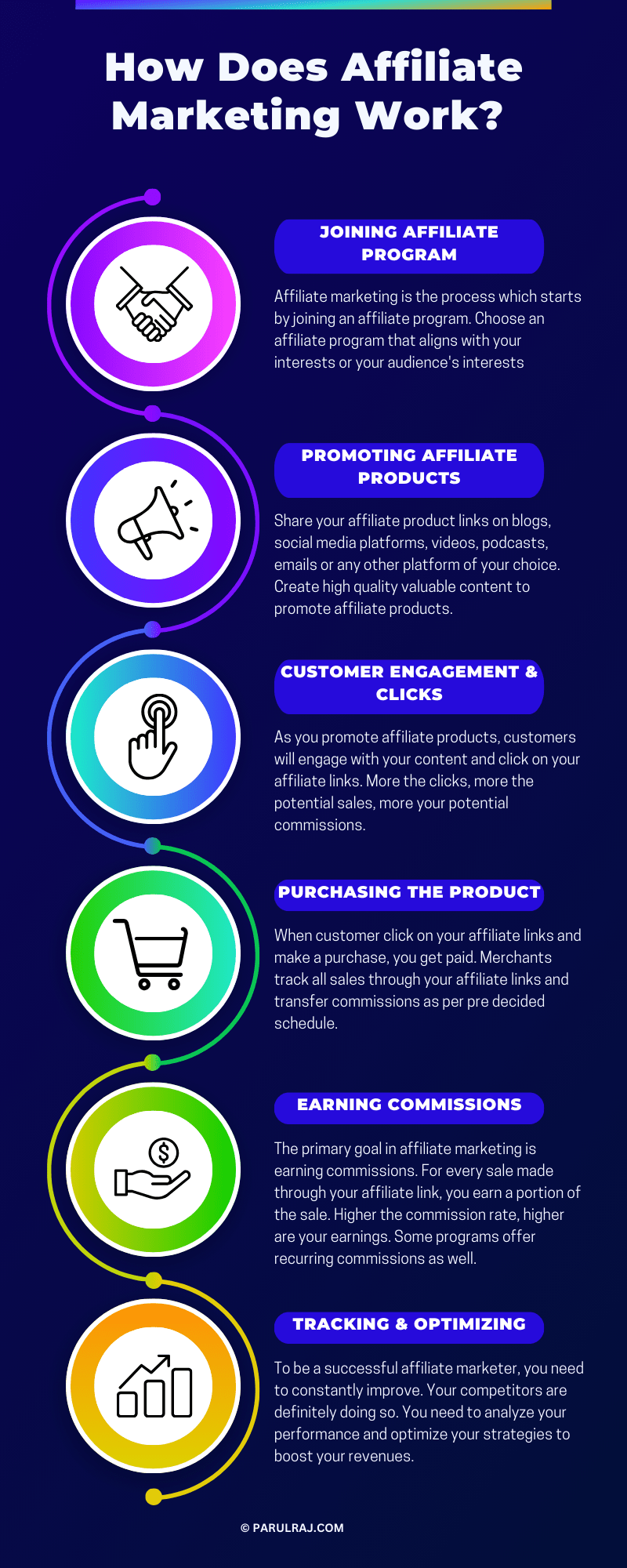
Joining an Affiliate Program
Affiliate marketing is the process which starts by joining an affiliate program or an affiliate marketing network which is a collection of many affiliate programs. Some of the popular affiliate networks are Amazon Associates, CJ, ShareASale, Awin.
Merchants create an affiliate marketing program to encourage individuals or other businesses to promote their products or services.
When you join an affiliate program, you’re provided with a unique affiliate id and affiliate link. This link is like your ID, tracking the sales that come from your marketing endeavors. When customers clicks on your link and make a purchase, you i.e. the affiliate is paid commission as determined by the marketing program.
Some affiliate programs are easy to join, while others might have a few more steps involved, ensuring you’re a good fit for their brand.
It’s crucial to choose an affiliate program that aligns with your interests or your audience’s interests. This alignment helps in promoting products or services authentically.
Promoting the Products or Service
Once you have signed up for an affiliate program and have received your affiliate link, you start affiliate marketing campaign.
Many affiliate marketers share this link on their blog, include affiliate links in their social media posts and emails. You can promote your affiliate links through any marketing platform.
The main objective should be that your content provides value, explains the benefits of the affiliate marketing products or services you’re promoting, and why your audience should consider making a purchase.
Engaging posts, informative blog articles, or even tutorial videos showcasing the product can work wonders. The aim is to attract and convince your audience to click on your affiliate link and check out the offering.
Engagement and Clicks
As you keep promoting, engagement begins. People will start clicking on your affiliate link to learn more about the product or service.
Each click is a potential sale, which results in increasing affiliate revenue.
Keeping track of your affiliate link clicks, understanding what strategies drive more engagement, and learning from the feedback can be beneficial. This data helps in fine-tuning your marketing strategies for better engagement and more clicks.
Making a Purchase
When individuals click on your affiliate link and decide to make a purchase, that’s when you get paid. The merchant tracks these sales through your affiliate link, ensuring that the commission for those sales gets credited to you.
The tracking is automated, so you don’t have to worry about keeping a manual tally. However, understanding the conversion rate—how many clicks turn into actual sales—can provide insights to further optimize your promotion strategies.
Earning Commissions
The primary goal in affiliate marketing is earning commissions.
For every sale made through your affiliate link, you earn a portion of the sale.
The commission rates vary from program to program. Some may offer a flat rate per sale, while others might offer a percentage of the sale amount.
These commissions are usually paid out on a schedule—monthly or quarterly—and it’s a rewarding experience to see the commissions roll in as a result of your marketing efforts.
Tracking and Optimization
Successful affiliate marketing doesn’t end with earning commissions. It’s about constant analysis and optimization. Tools are available to track the performance of your marketing efforts, providing valuable data on what’s working and what needs improvement.
By analyzing the data, optimizing your strategies, and perhaps even testing new marketing channels, you can boost your affiliate marketing performance.
Continuous optimization helps in growing your commissions over time, making your affiliate marketing journey more fruitful.
With patience, testing, and optimization, the cycle of promoting and earning through affiliate marketing continues, opening doors for increased earnings and better understanding of your audience’s needs and preferences.
Benefits of Affiliate Marketing For Beginners
Before we go into specifics of affiliate marketing, let’s understand why you should consider this business model. This section presents benefits of affiliate marketing for beginners i.e. why affiliate marketing is a great choice for beginners.
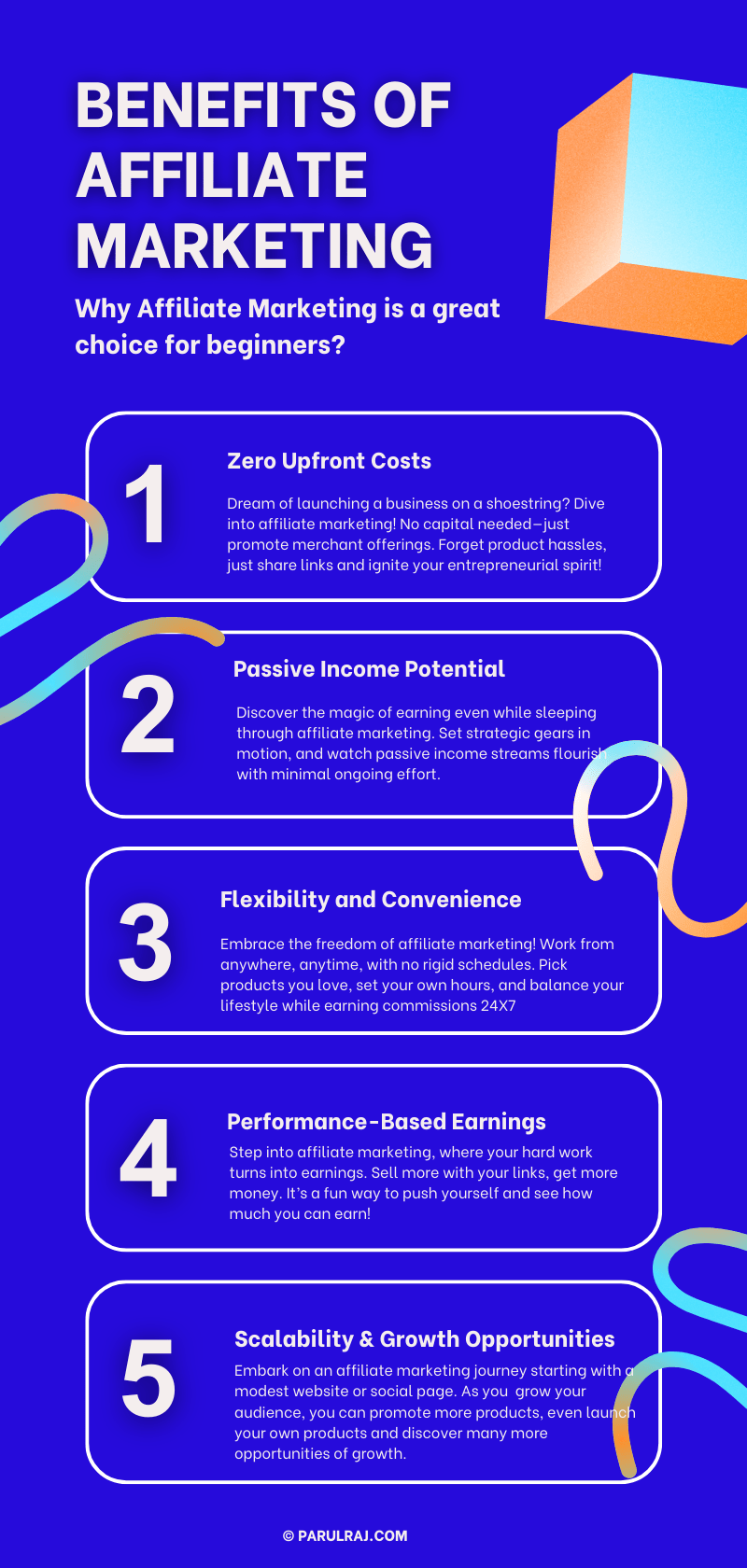
Zero Upfront Costs
Ever thought of starting a business with minimal upfront costs? You can start affiliate marketing without any money.
Unlike traditional business models, you don’t need a huge capital to start. Your primary role is promoting products or services for a merchant.
No need to worry about product creation, storage, or shipping. Just a platform to share your affiliate links and you’re good to go. It’s a budget-friendly way to step into the business realm!
Passive Income Potential
Who doesn’t dream of earning money while sleeping? With affiliate marketing, this dream can turn into reality.
Once your marketing strategies are in place and working 24/7, they can generate income even when you’re not actively working.
It’s about creating a passive income stream that adds to your earnings with lesser ongoing effort.
Flexibility and Convenience
Imagine working from anywhere, at any time, with no strict schedules. That’s the flexibility affiliate marketing offers!
It empowers you to work at your own pace, choose the products you want to promote, and decide your working hours.
It’s all about creating a balance that suits your lifestyle while earning money through your marketing efforts.
Performance-Based Earnings
Affiliate marketing is a realm where your efforts are directly rewarded. The more sales you generate through your affiliate links, the more commission you earn.
It’s a performance-based earning model that motivates you to optimize your marketing strategies for better results.
So, the sky’s the limit when it comes to how much you can earn. It’s a motivating factor that drives you towards achieving more.
Scalability & Growth Opportunities
As you start doing affiliate marketing as a beginner and grow you business, you will discover numerous opportunities to scale your business.
You could start with a simple website or a social media page. As you grow, you can use your audience base to expand your income streams and sell more affiliate products or may be products of your own.
Your growing audience means a broader stage to showcase more products and rake in more commissions.
Common Affiliate Marketing Channels
The best part about affiliate marketing is the flexibility. You can choose any channel to promote your products.
Different channels cater to varying audience types and marketing strategies. Here’s a closer look at some of these channels:
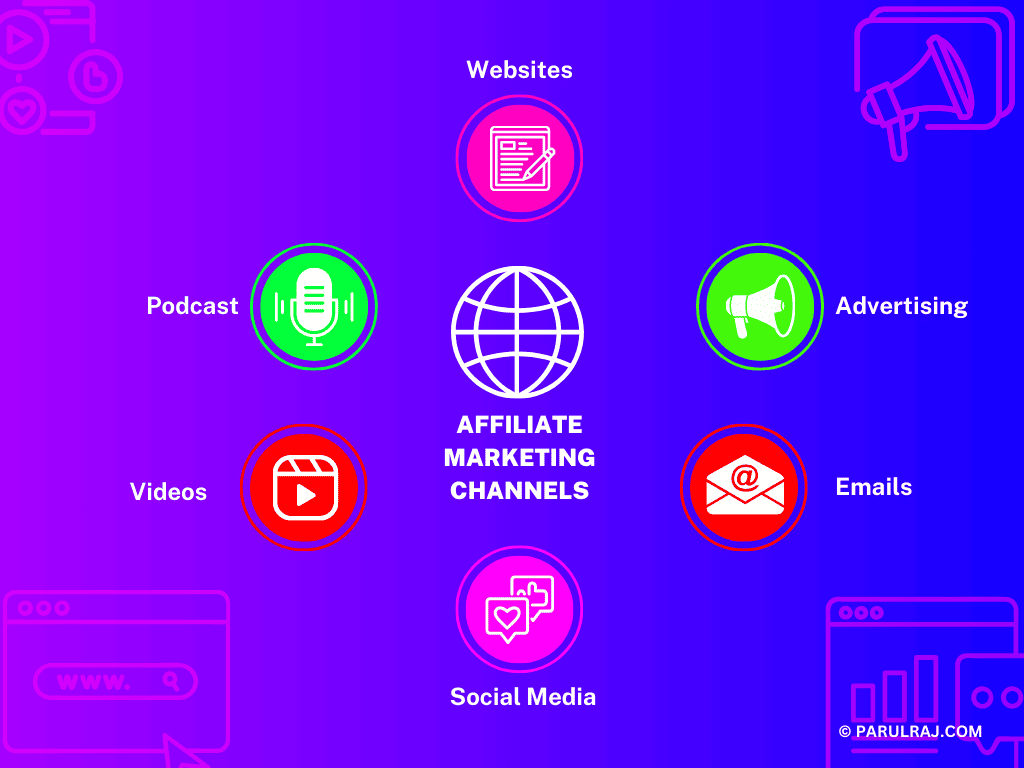
Blogs and Websites
Blogs and websites are classic channels for affiliate marketing. By creating content that resonates with your audience and subtly introducing affiliate links, you pave the way for organic affiliate sales.
Writing blog posts that solve problems, answer questions, or review products, all while incorporating your affiliate links, can be a compelling way to drive sales.
When readers find value in your content, they’re more likely to click on your affiliate links and explore the products you recommend.
Social Media
The omnipresence of social media has made it a potent channel for affiliate marketing. Platforms like Instagram, Facebook, and Twitter are fertile grounds for promoting affiliate products.
Creating engaging posts, sharing reviews, or even going live to talk about the products you’re promoting can grab your audience’s attention.
Your followers can easily click on your affiliate links right from the social media platforms and make purchases, driving your affiliate sales up.
YouTube
YouTube is a visual platform that’s excellent for affiliate marketing. By creating video content, you can visually demonstrate a product’s features and benefits, leading to better audience understanding and engagement.
Including your affiliate links in the video description or during the video encourages viewers to explore the products further.
Product reviews, tutorials, or unboxing videos are some of the creative ways to promote affiliate products on YouTube.
Email Marketing
Email marketing is a more direct approach to affiliate marketing. By crafting compelling emails and incorporating your affiliate links, you can reach out to an interested audience directly in their inboxes.
Segmenting your email list based on interests or past behaviors can further personalize your affiliate marketing efforts, promoting relevant products to the right segments, which could significantly boost your conversion rates.
Paid Advertising
Paid advertising is a quicker, albeit costlier, route to driving traffic to your affiliate links.
Platforms like Google Ads or Facebook Ads allow you to target specific demographics or keywords, bringing a stream of targeted traffic to your affiliate offers.
It’s essential to monitor your advertising spend and the returns it’s generating to ensure profitability.
With the right strategy, paid advertising can significantly amplify your affiliate marketing efforts, bringing in more clicks and conversions.
SEO (Search Engine Optimization)
SEO is a long-term strategy aimed at improving your website’s visibility on search engines.
By optimizing your content for relevant keywords, you can attract organic traffic to your website and, subsequently, to your affiliate links.
High-ranking content on search engines is perceived as more trustworthy and credible, which can boost click-through rates on your affiliate links.
Although SEO requires time and consistency, the organic traffic and potential earnings from affiliate marketing can be well worth the effort.
Types of Affiliate Marketing
We can categorize affiliate marketing into three types: Unattached, Related, and Involved Affiliate Marketing.
Each type has its own way of working and needs different levels of effort from the affiliate marketer. Uncovering the details of each type will help you choose the right path in your affiliate marketing journey.
Unattached Affiliate Marketing
Unattached affiliate marketing is like a no-strings-attached relationship in the marketing world. In this model, you don’t need to have a deep connection with the products or services you promote.
Following are the main features:
- Low Involvement: You don’t have to know the products inside out.
- Online Advertising: You use online ads such as Google Ads or Facebook Ads to promote affiliate links.
- Direct Traffic: People see your ads and click on the affiliate link.
- Making a Sale: If they buy the product, you earn a commission.
Unattached affiliate marketing is straightforward but competitive. You compete with many others doing the same thing.
But with the right strategy, you can make a place for yourself in this space. It’s a good starting point if you want to dive into affiliate marketing without getting too involved.
Related Affiliate Marketing
Related affiliate marketing is a step closer to the product or service as compared to the unattached model. Here, you have some relation to the products but not a deep-rooted one. This model suits those who have platforms or channels that cater to a specific niche.
Following are the main features:
- Basic Knowledge: You have a general understanding of the products or services.
- Niche Alignment: Your platform or channel is related to the products you promote.
- Promotion: You share affiliate links on your blog, social media, or other platforms.
- Engagement: Your audience engages with your content and clicks on the affiliate links.
- Commission: When they make a purchase, you earn a commission.
Related affiliate marketing allows you to stay in your comfort zone, dealing with a niche you are familiar with. Yet, you don’t need to get too involved with the products.
It’s a balanced approach to affiliate marketing, making it appealing to many beginners.
Involved Affiliate Marketing
Involved affiliate marketing is like being in a close friendship with the products you promote. You know them well, you use them, and you believe others would benefit from them too. This model is for those who prefer a hands-on approach.
Let’s explore this:
- Personal Use: You use the products or services you promote, and share your experience with your audience.
- Deep Understanding: You understand the ins and outs of the products.
- Content Creation: You create detailed content like reviews, tutorials, or guides.
- Trust Building: People trust your recommendations because you’ve used the products, resulting in higher clicks.
- Commission Earning: When people click on your affiliate link and buy, you earn a commission.
Involved affiliate marketing is a rewarding but time-consuming approach. You invest time in understanding the products and creating helpful content.
The trust you build with your audience can lead to a stable income.
If you love diving deep into your niche and sharing your experiences, this is a great affiliate marketing approach with high returns.
Getting Started With Affiliate Marketing: How to Make Money With Affiliate Marketing & Become An Affiliate Marketer
Beginning with affiliate marketing is like setting off on a thrilling adventure. There’s a lot to discover, do, and of course, earn. Yet, before we jump in, there are some key steps to take for a smooth journey. Let’s explore these steps one by one.
Setting Clear Objectives
Knowing what you want to achieve is the first big step. You might want to earn some extra money, share things you love, or even start a new career. Having clear goals helps you stay on track.
Think about what you want to achieve. Is it making money? Is it sharing your passion for a certain topic? Or is it helping others? Write your goals down on a paper. It’s exciting to see them become real as you work on them.
Your goals guide your decisions. They help you choose the right topics and the right companies to work with. Every time you need to decide something, think about your goals. Will this help you reach your goals? If yes, go for it!
Researching and Choosing the Right Niche
Choosing a topic or a niche is the next step. When you are passionate about your topic, working on it is fun. And when it’s fun, you do a better job.
Take some time to think about what you love. It could be anything like games, cooking, or sports. Write down your ideas. Then, look at what other people are interested in. Is there a way to match your passion with other people’s needs? That’s your sweet spot.
Also, look for topics that have things to sell. This is how you make money. You share your knowledge, talk about products and technologies which you like, people buy them, and you earn money. It’s a win-win for everyone!
Identifying and Joining Affiliate Programs
Now it’s time to find companies that offer an affiliate program. They have products & services to sell, and you can help them.
Choose programs that match your topic or your niche. If you love games, look for companies that sell games. This way, it’s easy to talk about and promote products because your audience will be interested in those.
Choosing the Best Suited Channel
Next, you need to select a channel which is best suited to your marketing skills. If you are great content writer, then go for a blog. If you are comfortable in front of a camera, then choose videos as your channel.
Think about what you enjoy doing. Then, choose a channel that matches your preferred way of working. This will make it easier to generate high quality content to promote your affiliate products.
Legal Considerations
Every game has rules. And so does affiliate marketing. Knowing the rules keeps you safe. It’s important to be fair and honest. This way, people trust you and companies like working with you.
Learn about the rules of affiliate marketing. There are rules about telling people that you earn money when they buy through your links. There are also rules about what you can and can’t say when you share things.
Knowing the rules and playing fair makes your affiliate marketing adventure a good one. It helps you build a good name and keep your money safe.
Affiliate Marketing Strategies for Success
As is clear from sections above, launching the affiliate marketing business, especially for beginners, is not tough. A bit of research and a bit of work, and you can start promoting affiliate products.
But affiliate marketing is not a get-rich-quick scheme. It requires effort and skill.
Employing the right strategies can shorten your time to success an can help grow your affiliate revenues fast.
Following are some strategies which you can use to make your affiliate marketing campaigns successful.
Creating High-Quality, Valuable Content
Picture a place where everyone shares exciting stories. Your content is your story.
When you weave in helpful tips, personal experience, interesting facts, or solutions in your story, people listen. They come to you for answers. They share your story with others.
When your readers find value, they are more likely to trust your advice and click your links to buy your recommended products.
SEO and Keyword Research
SEO & keyword research helps your content become easily discoverable on search engines like Google.
When someone looks for answers on the internet, the right keywords help them find your posts.
Employing SEO techniques and selecting relevant keywords can help drive ton of organic traffic to your blog or website which will boost your affiliate sales.
Building an Audience
Your aim should be to use your content (whether posts, videos or blogs) to develop audience who trust you and is interested in looking at your content.
Having a solid audience base helps get more eye balls on your content which results in more engagement culminating higher sales or commissions.
You can choose any channel to build your audience, but the objective remains the same – use high quality content representing genuine experiences to build rapport and become their go-to-person to get all information & advice in your niche.
Social Media Promotion
You don’t need a website to promote products.
Social media platforms are great way to share your content, engage with your audience and promote affiliate products.
You can use many creative ways to generate buzz about your affiliate products – contests, quizzes, fun facts and videos. More buzz you create, more engagement you get, more money you will make.
Email Marketing Tactics
Email marketing is a great way to grow your audience and engage with them on a regular basis.
With each email, you keep your readers in the loop about the latest content you’ve added, the cool products you’ve discovered, and how they can benefit from them.
Personalize your emails, make them engaging, and see the clicks on your affiliate links soar.
Paid Advertising (PPC) Strategies
PPC strategies are amazing when you don’t have followers or dedicated audience on any platform.
Paid advertising helps get your content in front of target audience fast with just a little investment. You get to choose where your ads show, who sees them, and how they look.
This strategy can help you generate affiliate revenue while you are still working on building your audience on the platform of your choice.
Troubleshooting Common Challenges
As you venture deeper into affiliate marketing as a beginner, you’ll encounter various challenges along the way. This section addresses common obstacles and provides strategies to overcome them, ensuring your affiliate marketing journey remains on track.
Dealing with low conversion rates
Conversion rate is a measure of how well your affiliate marketing campaign is performing i.e. of all the people who clicked on your affiliate links, how many actually purchased the product.
High conversion rate means that if people are clicking on the affiliate link, then a good number of them are purchasing the product as well.
Low conversion rate represents more click on links but not enough sales i.e. very low commissions.
Low conversion rates can be frustrating, but they’re a common challenge in affiliate marketing. To improve conversions, consider these strategies:
- Optimize Your Content: Review your content to ensure it’s engaging and persuasive. Use clear and compelling calls-to-action (CTAs) to encourage clicks. More confidence you inspire in your readers, the faster they will purchase.
- A/B Testing: Experiment with different approaches, such as changing your CTAs, altering the placement of affiliate links, or refining your content structure. A/B testing can reveal what resonates best with your audience.
- Audience Targeting: Refine your audience targeting to ensure your content reaches the right people who are more likely to convert.
Remember, improving conversion rates takes time and experimentation. Be patient and persistent in your efforts.
Overcoming competition
The affiliate marketing landscape can be competitive, especially in popular niches with high commissions. To stand out try following techniques:
- Niche Down: Consider narrowing your niche to focus on a more specific and less saturated segment.
- Create Unique Content: Offer something different from your competitors. Share personal experiences, in-depth insights, or unique angles on affiliate products.
- Build Relationships: Establish connections with other affiliates and influencers in your niche. Collaboration can help you reach a broader audience.
Competing in affiliate marketing requires creativity and adaptability. By differentiating yourself and continuously improving your strategies, you can succeed even in competitive niches.
Adapting to algorithm changes (e.g., Google updates)
Search engine and social media algorithm changes can impact your traffic and rankings. To adapt:
- Stay Informed: Keep up-to-date with industry news and algorithm changes. Follow authoritative sources and forums for updates.
- Diversify Traffic Sources: Don’t rely solely on one traffic source. Diversify your traffic by exploring multiple platforms and channels.
- Quality Content: Focus on creating high-quality, evergreen content that provides long-term value. This can help maintain your search engine rankings.
Algorithm changes are inevitable, but a flexible and proactive approach can help you navigate them effectively.
Affiliate Marketing Without A Website
Doing affiliate marketing with a website is one of the most common approach but it is definitely not the only approach. There are many ways to do affiliate marketing without a website. Social media platforms, email marketing, podcasts and videos are a few other ways which you can use to promote affiliate products.
Discover 10 easy ways to do affiliate marketing without a website.
Affiliate Marketing Without Followers
Creating a successful affiliate marketing business is possible without followers as well. Using paid ads, creating sponsored content are a few other ways to promote products. Check out this post which details strategies which you can employ to get your affiliate revenue going without any audience.
Learn 15 powerful ways to do affiliate marketing without followers.
Monetizing Affiliate Marketing Efforts: How to Increase Your Affiliate Income
You’ve ventured into the affiliate marketing world, overcome challenges, and built your business. Now, it’s time to enjoy rewards of your hard work i.e. earning money through your links. Let’s explore the various ways of monetizing your affiliate marketing efforts.
Affiliate Marketing Tips to Increase Your Revenue
Earning money through affiliate marketing is straightforward. You promote products via affiliate links and when people buy using your links, you get commission. But, there are ways which can help you increase your affiliate revenue multifold.
1. Diversify Your Affiliate Programs:
- Work with a variety of affiliate programs related to your niche.
- This broadens your chances of earning, as you can promote different products or services.
2. Optimize Your Content:
- Fine-tune your content for conversions.
- Optimize the content using SEO to get more organic traffic.
- Use compelling calls to action (CTAs) that encourage readers to click on your affiliate links.
3. Product Reviews:
- Write in-depth, honest product reviews.
- Share the pros and cons to help your audience make informed decisions.
4. Email Marketing:
- Use email campaigns to reach out to your audience.
- Share valuable content and product recommendations.
5. Seasonal Promotions:
- Capitalize on holidays and special events.
- Promote products or services that are relevant to the season.
- Share information about ongoing discounts and offers which can help drive the sales.
6. A/B Testing:
- Experiment with different strategies.
- Analyze what works best and refine your approach.
These strategies are like tools in your affiliate marketing toolbox. Use them wisely, and you’ll see your affiliate marketing earnings grow.
Diversifying Income Streams
With the fast pace of technological development, all industries are changing rapidly. Products are becoming defunct faster and new products are entering the market on a daily basis.
This kind of volatility can affect your affiliate marketing business adversely.
So, you should try to diversify your affiliate revenue sources and following are some of the ways you can do that:
1. Explore Different Niches:
- If you’re passionate about more than one topic, consider affiliate marketing in multiple niches.
- This spreads your earnings across different areas.
2. Create Multiple Revenue Sources:
- Besides affiliate marketing, explore other ways to earn online.
- You could offer consulting, sell digital products, or even create your own courses.
3. Invest in Passive Income Streams:
- Some affiliate programs offer recurring commissions.
- This means you earn money not just from one sale but from ongoing subscriptions.
4. Explore Affiliate Networks:
- Different networks might have different offerings.
- Joining more than one network gives you access to a wider range of products.
5. International Markets:
- Don’t limit yourself to one geographic region.
- Explore affiliate programs and products that cater to international audiences.
By diversifying your income streams, you create a financial safety net and ensure that even if one source isn’t performing as expected, others are still flowing strong.
Daily Paying Affiliate Programs
Daily paying affiliate programs are like instant rewards for your efforts. They allow you to reap the benefits of your hard work without waiting for weeks. Here’s how to tap into this potential:
1. Choose Programs with Fast Payouts:
- Look for affiliate programs that offer daily or weekly payouts.
- This ensures you get your earnings quickly.
2. Consider Digital Products:
- Some digital product affiliate programs offer instant commissions.
- When someone buys, you see the money in your account immediately.
3. Affiliate Networks:
- Join affiliate networks that provide daily payouts as an option.
- This is common in networks that deal with digital products and services.
4. Cashback and Coupon Sites:
- Some cashback and coupon websites offer instant cashback or discounts.
- You can promote these and earn commissions swiftly.
5. Read the Fine Print:
- Always read the terms and conditions.
- Ensure you understand how the program’s payout system works.
Daily paying affiliate programs can be a great boost to your cash flow, especially if you’re looking for quick returns on your affiliate marketing investments.
Check out this list of affiliate programs which pay daily and weekly.
Affiliate Marketing Tools & Technology
Utilizing AI in Affiliate Marketing
AI, short for Artificial Intelligence, is like a smart friend in the digital world. It helps in many ways in affiliate marketing. Here’s how:
- Understanding Trends: AI can look at lots of data quickly. It helps understand what products are trending. This way, you know what might sell well.
- Personalizing Content: AI helps to show the right content to the right people. It makes your messages feel personal, which can lead to more sales.
- Automating Tasks: With AI, you can automate boring tasks. It saves you time to focus on more fun and important things.
- Improving Decisions: AI gives you insights from data. It helps you make better decisions to boost your earnings.
ChatGPT is a great example of a AI based smart tool which you can use to amplify your affiliate marketing success.
Learn 11 powerful ways to use ChatGPT for affiliate marketing and earn high revenue.
Tracking Your Performance
Tracking your performance is key skill which you need to master as an affiliate marketer. It tells you how well you are doing. Here are some ways to track your performance in affiliate marketing:
- Use Tracking Codes: Affiliate programs often have tracking codes. They help you see how many clicks and sales you are getting.
- Analyze Data: Look at the data to see what’s working and what’s not. It helps you improve.
- Use Tools: There are tools that help track performance. They show you useful info like clicks, sales, and earnings.
- Set Goals: Setting goals helps you aim higher. Tracking your performance helps you see if you are meeting your goals.
Creating Effective Landing Pages
Landing pages are one page websites or dedicated web pages on your website which serve as the sales pitch for your affiliate products. They invite people to learn more and buy. Making good landing pages is can grow your affiliate income significantly. Here’s how:
- Clear Message: Your landing page should have a clear message. It should tell people what to do next like buying or signing up.
- Appealing Design: A nice design makes your landing page inviting. It should look good and be easy to read.
- Loading Speed: People don’t like to wait. Make sure your landing page loads fast.
- Mobile Friendly: Many people use phones to shop. Make sure your landing page looks good on phones too.
- Test and Improve: Test different things on your landing page to see what works best. It helps you improve and sell more.
Addressing Common Misconceptions
In any field, there are myths and misconceptions which can confuse any beginner. Affiliate marketing is no different. Let’s clear up some common misunderstandings to set the right track for your affiliate journey.
Affiliate Marketing vs MLM
People often mix up Affiliate Marketing and MLM (Multi-Level Marketing), but they are different games. Let’s look at some key differences:
Single Level vs Multi-Level:
- In Affiliate Marketing, you earn from the sales you make. It’s a one-level thing.
- MLM involves earning through sales and the sales made by people you recruit. It’s many levels deep.
Recruitment:
- In Affiliate Marketing, there’s no need to recruit others to earn money.
- MLM often needs you to build a team to earn more.
Product Focus:
- Affiliate Marketing focuses on promoting products.
- MLM focuses on recruiting and may have less emphasis on product sales.
If you are still not clear about the differences, then check out this comparison post which explains in detail how affiliate marketing is not same as a multi level marketing scheme.
Is Affiliate Marketing a Pyramid Scheme?
Some people think that affiliate marketing is a pyramid scheme. This is not true and here’s why:
Earning Style:
- In Affiliate Marketing, earnings come from real sales.
- Pyramid schemes make money from recruiting people, not from selling products.
Legality:
- Affiliate Marketing is a legal way to earn money.
- Pyramid schemes are illegal in many places because they are unfair.
This guide explores this misconception in detail.
Questioning whether Affiliate Marketing is Worth It?
Is Affiliate Marketing worth your time? This is a valid question and following are some reasons which can help you make that decision:
Startup Costs:
- Affiliate Marketing needs less money to start compared to other businesses.
- You don’t need to create a product. You just promote products that are already there.
Earning Potential:
- With the right strategies, Affiliate Marketing has good earning potential.
- It might take some time to see earnings, but with effort, it can be a steady income source.
Flexibility:
- You can work from anywhere and choose your working hours in Affiliate Marketing.
- It offers a flexible way to earn money.
Key Metrics in Affiliate Marketing Programs
Now that you have a good understanding about affiliate marketing business model and are convinced that it is worth your time & effort, let’s look at some key metrics or KPIs (key performance indicators) which can help keep track of your campaign progress.
EPC (Earnings Per Click)
EPC tells you how much you earn each time someone clicks on your affiliate link. It’s a good way to see how profitable a product is.
Formula:
EPC = (TotalEarnings) / (TotalClicks)
Example: If you earned $100 from 200 clicks, your EPC would be:
EPC = $100 / 200 = $0.50
So, for every click, you earned 50 cents.
Checkout this beginner friendly guide to Earnings per Click (EPC) and how to improve it.
Affiliate ID
Affiliate ID is like your name tag in the game. It helps track your sales and earnings.
When you join an affiliate program, you get a unique Affiliate ID. It’s used in the affiliate links you share. This way, the program knows when you made a sale.
Example: Your affiliate link may look like this: www.productsite.com/?affid=12345. Here, 12345 is your Affiliate ID.
Conversion Rate (CVR)
Conversion Rate tells you how often clicks on your affiliate links turn into sales for the merchant. It’s a key metric to see how well your affiliate campaign is doing.
Formula:
CR = (NumberofConversions / NumberofClicks) ∗ 100
Example: If you had 10 sales from 200 clicks, your conversion rate would be:
CR=(10/200)∗100=5
This means 5% of the clicks turned into sales.
Click-Through Rate (CTR)
Click-Through Rate shows how often people click your affiliate links when they see them.
Formula:
CTR = (NumberofClicks / NumberofImpressions) ∗ 100
Example: If your link got 200 clicks from 1,000 impressions, your CTR would be:
CTR=(200/1000)∗100=20
This means 20% of the time, your link was clicked when seen.
Return on Advertising Spend (ROAS)
Return on Advertising Spend (ROAS) is a metric that tells you how much money you make for every dollar spent on advertising. It helps gauge the effectiveness of your advertising campaigns.
Formula:
ROAS = (RevenuefromAds) / (CostofAds)
Example: If you made $500 from an ad campaign that cost $100, your ROAS would be:
ROAS = $500 / $100 = 5
This means you earn $5 for every $1 spent on advertising.
Customer Acquisition Cost (CAC)
Customer Acquisition Cost (CAC) is the price you pay to acquire a new customer. It’s crucial for understanding the profitability of your affiliate marketing endeavors.
Formula:
CAC = (TotalMarketingExpenses) / (NumberofNewCustomersAcquired)
Example: If you spent $200 on marketing and acquired 20 new customers, your CAC would be:
CAC = $200 / 20 = $10
This means, on average, it cost you $10 to acquire each new customer.
Average Order Value (AOV)
Average Order Value (AOV) tells you the average amount of money spent each time a customer places an order through your affiliate link. It helps understand your earnings per order.
Formula:
AOV = (TotalRevenue) / (NumberofOrders)
Example: If you made $500 from 50 orders, your AOV would be:
AOV = $500 / 50 = $10
This means the average order amount is $10.
Lifetime Value (LTV)
Lifetime Value (LTV) is a prediction of the total money you’ll earn from a customer throughout the entire time they interact with your affiliate links.
Formula:
LTV = (AverageOrderValue) ∗ (NumberofRepeatTransactions) ∗ (AverageRetentionTime)
Example: If the average order value is $10, and a customer makes 10 purchases over 2 years, the LTV would be:
LTV = $10 * 10 * 2 = $200
This means, on average, you could earn $200 from each customer over a 2-year span.
Conclusion
Starting with affiliate marketing might feel like stepping into a big, puzzling domain at first. But, with a good guide, you can find a clear path that takes you to the exciting goal of making a good amount of money online. This guide wants to be that helpful map for you, giving a full picture from simple ideas to detailed plans that help achieve success in affiliate marketing.
As we wrap up this enlightening journey, let’s revisit the essence and take home some key takeaways:
– Understanding Affiliate Marketing: At its core, affiliate marketing is about promoting products for others and earning a commission for each sale made through your unique affiliate link. The main players in this domain are the merchants, affiliates, and consumers.
– Types of Affiliate Marketing: We explored the various types, namely unattached, related, and involved affiliate marketing, each with its own set of advantages and requirements.
– Getting Started: Setting clear objectives, choosing the right niche, identifying and joining suitable affiliate programs, and adhering to legal considerations form the foundation of a successful affiliate marketing venture.
– Strategies for Success: Crafting high-quality content, mastering SEO, building a loyal audience, and regularly analyzing and optimizing your performance are crucial strategies for thriving in this competitive field.
– Overcoming Common Challenges: We delved into dealing with low conversion rates, overcoming competition, adapting to algorithm changes, and the possibilities of succeeding without a website or a large following.
– Monetization and Diversification: Monetizing your affiliate marketing efforts and diversifying your income streams ensures a stable and growing income.
– Tools and Technology: Leveraging modern tools and technology like AI, performance tracking tools, and effective landing pages can significantly boost your effectiveness and earnings.
– Addressing Misconceptions: Dispelling common myths and understanding the differences between affiliate marketing, MLM, and pyramid schemes clears the path for a factual understanding of the field.
– Key Metrics: We dissected essential metrics like EPC, Conversion Rate, and Lifetime Value, among others, that provide insights into your performance and areas of improvement.
Affiliate marketing is a big area with many chances for those ready to work hard. It has some challenges, but with the right information, a strong will, and a constant wish to learn and adjust, overcoming these challenges and reaching great success is possible.
Now, as you start this exciting work, it’s important to have the right knowledge and plans from this guide. The steps have been shared, the plans are ready, and now it’s your time to start and explore affiliate marketing. As you move ahead, remember that success in affiliate marketing takes time. It’s a slow move up, but with every step, you get closer to making good money online and having financial freedom.
Begin this hopeful journey with an open mind, a willing to learn, and the excitement to improve and grow. The field of affiliate marketing is ready, full of chances for good earnings, personal growth, and the cool chance of creating a successful online business.






